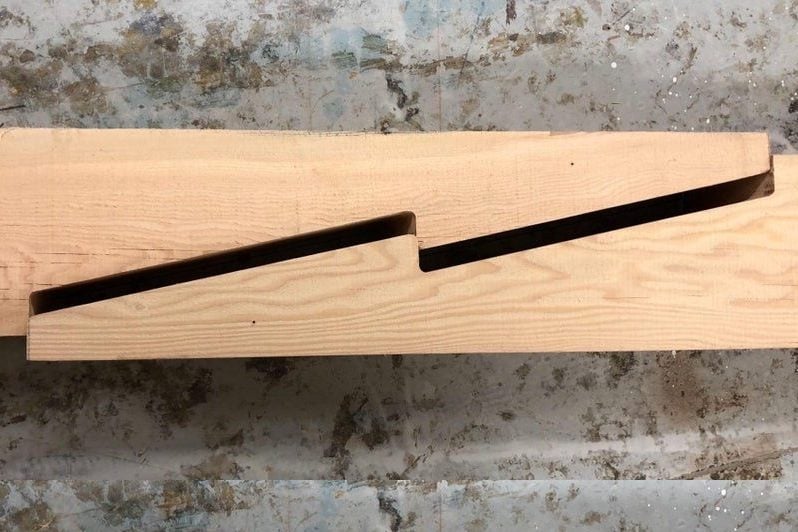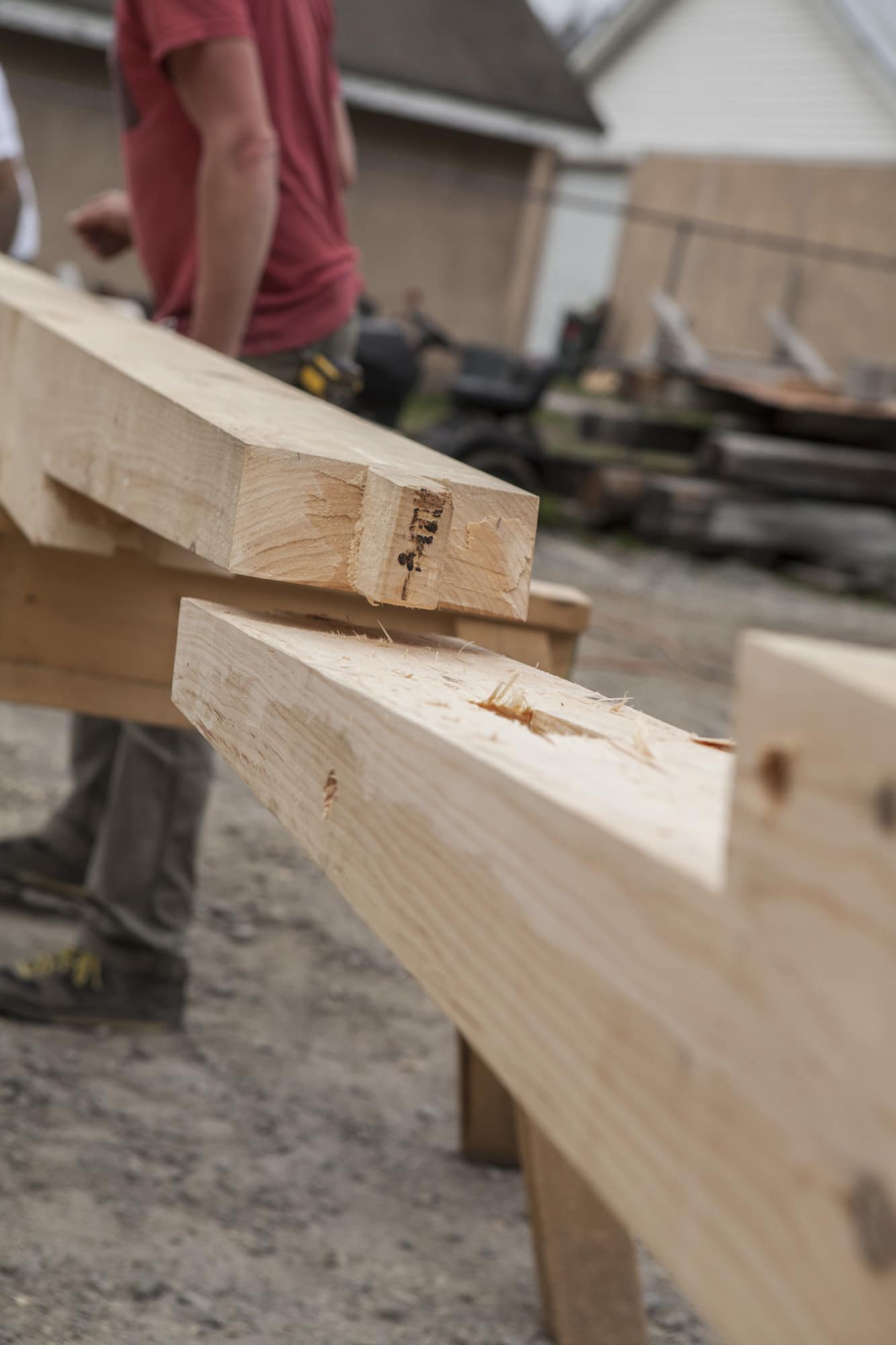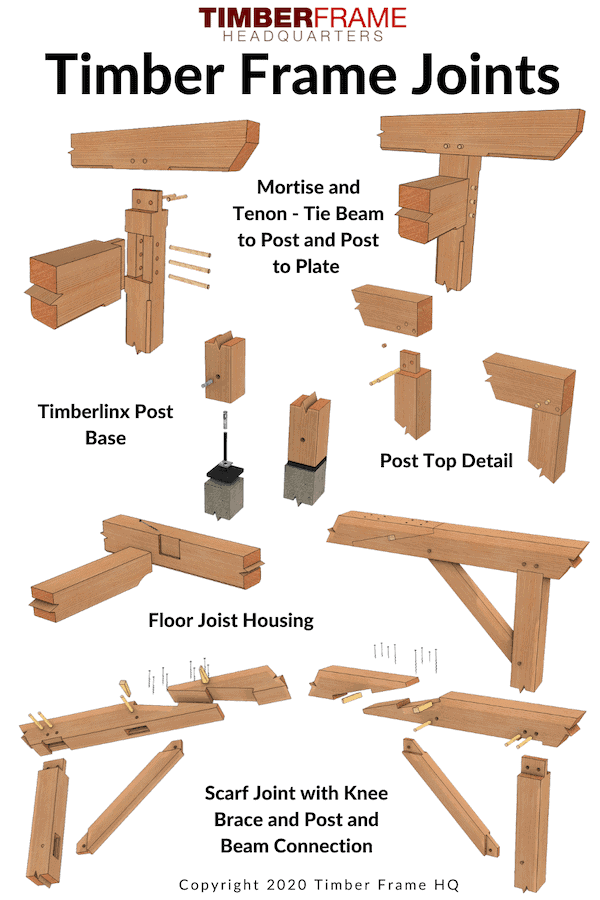
Spectacular Diy Support Beam 30 X 24 Butcher Block Countertop
Pryda Nail-On Connector Plate 75 x 125mm Box 60. (0) $68 .47. Compare. Special Order. Pryda 900 x 32mm Cyclone Strap - Pack of 25. (0) $69 .98. Compare.

Types Of Wood Beam Joints The Best Picture Of Beam
To make a mitered butt joint, cut the edge of the wood at a 45 degree angle. To fasten the two pieces together, add glue and clamp until the glue dries. 4. Tongue-and Groove Joint. A tongue and groove wood joint is often used instead of edge to edge butt joints and it easily allows for one piece of wood to slide into another.

Timber Framing with Glulams THISisCarpentry
1 Secure the beams in a metal beam bracket. Choose a beam bracket that matches the width of the post and the combined thickness of your 2 pieces of timber. Put it on top of the post and drive wood screws or structural nails through the holes in the sides of the bracket into the post.

387 best images about Beams & Joints on Pinterest Woodworking joints, Post and beam and Pavilion
2) 2- Mitre Joint. 3) 3- Mortise and Tenon Joint. 4) 4- Dowel Joints. 5) 5- Rabbet joint. 6) 6- Lap Joint. 7) 7- Dado joint. 8) 8- Stopped dado joint. If you are a beginner, you may not be aware of the best woodworking joints. Some wood joints are made with nails and screws, and some are glued.

A rabbeted splice joint uses 90 degree angles and dowels to lock different timbers together
Your projects will turn out exactly the way you want them. Start a woodworking business and be engaged for a long time without running out of ideas

Timber Framing Scarf Joint YouTube
Wood joints are an essential aspect of woodworking, providing the necessary connections between pieces of wood in a structure or project. From simple butt joints to complex dovetail joints, these connections play a crucial role in determining the strength and stability of the final product.

9+ Splendid Decorative Wood Beam Brackets Gallery Post and beam, Patio flooring, Pergola
THE BUTT JOINT Among the first types of wood joints you're likely to encounter when installing trim in a home is the butt joint, which, true to its name, signifies two pieces of wood.

Oak framing, oak framed barns, garages and porches Timber frame joinery, Timber frame building
Technically a butt joint, a miter joint is an angled cut between two pieces of wood. The most common example is window and door trim, with 45-degree cuts on the ends of each board, creating a 90-degree angle when assembled. While this does provide more gluing area than a butt joint, it gets much stronger when assembled with biscuits or floating.

Joinery Post and Beam Barns The Barn Yard & Great Country Garages Wood joinery, Japanese
Cut a notch in the top of a post with a circular saw to keep the beams in the notch, drill two holes, and use mortise and tenon joints to join pieces of wood together. Mortise and tenon joints are useful for attaching boards both end to end and at right angles, and can be cut using a variety of methods. Mitered joints are a strong way to join.

Using the Scarf Joint to Gain Length in Your Timber Frame
Fast and Free Shipping On Many Items You Love On eBay. But Did You Check eBay? Check Out Wood Beams On eBay.

Pin en How to build a house
Home. Timber joint design. Bolts, coach screws and timber connectors (split-rings and shear-plates) all have higher capacities than nails and screws, making them better suited to applications where a large load is imposed and there is limited space for fasteners. Commonly, these are used in conjunction with proprietary and custom designed metal.

Scarf Joint for Wood Elegance and Strength Don Tai (Canada) Blog
A pocket joint might be one of the more familiar, even for the novice woodworker. To make a pocket joint, you drill an angled hole into one piece of wood and join it to another piece with a self-drilling washer head screw. It's a fast and easy way to join two pieces without the need for clamping them together. The key is the angled hole.

Timber Frame Joints and Joinery Timber Frame HQ
These joints have adjoining pieces that connect at an angle, which help transfer loads from horizontal to vertical timbers (think of a peg going into a hole). This joint typically has a 45° diagonal piece called a brace or strut that helps stabilize the beams. Because mortise and tenon joints are pegged, they can be stronger than lap joints.

316 best Wood & Steel Beams images on Pinterest Wood steel, Architecture details and
Miter joint. The miter joint is a corner joint made by cutting the ends of the wood pieces at a 45 degree angle. Reinforcement can be accomplished with glue, nails, splines or pocket holes. Pros: Creates a clean, seamless corner joint without visible end grain. Perfect for use as a frame or in a decorative setting.

In addition to supporting deck loads, these critical joints must be designed to resist uplift
Mark each joint on its top face and set the saw blade 3 ⁄ 4 " high?—half the length of the splines. Orient the top faces of each piece against your rip fence for consistent groove positions between pieces. To keep extra-long pieces steady, add an auxiliary fence.

Cedar Lumber * Cedar Beams Timbers 6x 8x 10x 12x * Prices and Pictures
Butt Joint The end of a timber board is called the "butt." Woodworkers forming this joint are placing two ends together at a right angle to create a corner. Mechanical fasteners such as nails or screws are necessary to preserve this joinery. You see this technique used most often when building wall or attic framing.